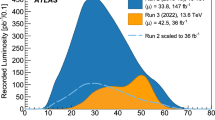Abstract
The ATRAP (antihydrogen trap collaboration) at CERN (European organization for nuclear research) has developed a completely new, larger and more robust apparatus in the second experimental zone. The antiproton annihilation detector system consists of 10 layers of scintillating fibers, counts the antihydrogen atoms and determines the annihilation vertex of the atoms. This diagnostic element will allow to optimize the production of cold antihydrogen sufficiently to permit the optical observations and measurements. Using this new apparatus thousands of antihydrogen atoms have been produced within a combined Penning-Ioffe trap. These observed antihydrogen atoms resolve a debate about whether positrons and antiprotons can be brought together to form antihydrogen atoms within the divergent magnetic fields of a quadrupole Ioffe trap.
Similar content being viewed by others
References
Gabrielse G. Atoms made entirely of antimatter: two methods produce slow antihydrogen. Adv At Mol Opt Phys, 2005, 50: 155–217
Ju Y L, Gu Y, Dodd J, et al. Detection of low energy solar neutrinos by a two-phase cryogenic e-bubble detector. Chin Sci Bull, 2007, 52(21): 3011–3015
Zhang Z D, Venanzi C, Nurdan K, et al. Window discriminator for multiwires chamber. IEEE Nucl Sci Symp Conf Rec, 2004, 3: 1432–1435
Hamamatsu Photonics K K. Multianode photomultiplier tube assembly H6568/H6568-10. Datenblatt, 2001
Zhang Z D. Detection of cold antihydrogen atoms. Ph.D. Thesis. Bochum: Rhur-University Bochum, 2007
Gabrielse G. Penning traps, masses and antiprotons. In: Bloch P, Paulopoulos P, Klapisch R, eds. Fundamental Symmetries. New York: Plenum, 1987. 59–75
Gabrielse G. Trapped antihydrogen for spectroscopy and gravitation studies: Is it possible? Hyperf Inter, 1988, 44: 349–355
Walz J, Hänsch T W. A proposal to measure antimatter gravity using ultracold antihydrogen atoms. Gen Relat Gravit, 2004, 36: 561–570
van Roijen R, Berkhout J J, Jaakkola S, et al. Experiments with atomic hydrogen in a magnetic trapping field. Phys Rev Lett, 1988, 61: 931
Cesar C L, Fried G D, Killian T C, et al. Two-photon spectroscopy of trapped atomic hydrogen. Phys Rev Lett, 1996, 77: 255
Squires T M, Yesley P, Gabrielse G. Stability of a charged particle in a combined Penning-Ioffe trap. Phys Rev Lett, 2001, 86: 5266
Gilson E P, Fajans J. Quadrupole-induced resonant-particle transport in a pure electron plasma. Phys Rev Lett, 2003, 90: 015001
Fajans J, Bertsche W, Burke K, et al. Effects of extreme magnetic quadrupole fields on Penning traps and the consequences for antihydrogen trapping. Phys Rev Lett, 2005, 95: 155001
Gabrielse G, Larochelle P, Le Sage D, et al. Antihydrogen production within a Penning-Ioffe trap. Phys Rev Lett, 2008, 100: 113001
Gabrielse G. Comparing the antiproton and proton, and opening the way to cold antihydrogen. Adv At Mol Opt Phys, 2001, 45: 1–39
Gabrielse G, Bowden N S, Oxley P, et al. Stacking of cold antiprotons. Phys Lett B, 2002, 548: 140–145
Author information
Authors and Affiliations
Corresponding author
Additional information
Supported by the NSF (Grant No. 0306308) and AFOSR of the US, the BMBF, MPG and FZ-Juelich of Germany, and the NSERC, CRC, CFI (Grant No. 3756) and OIT of Canada
About this article
Cite this article
Zhang, Z., Oelert, W., Grzonka, D. et al. The antiproton annihilation detector system of the ATRAP experiment. Chin. Sci. Bull. 54, 189–195 (2009). https://doi.org/10.1007/s11434-008-0536-6
Received:
Accepted:
Published:
Issue Date:
DOI: https://doi.org/10.1007/s11434-008-0536-6




